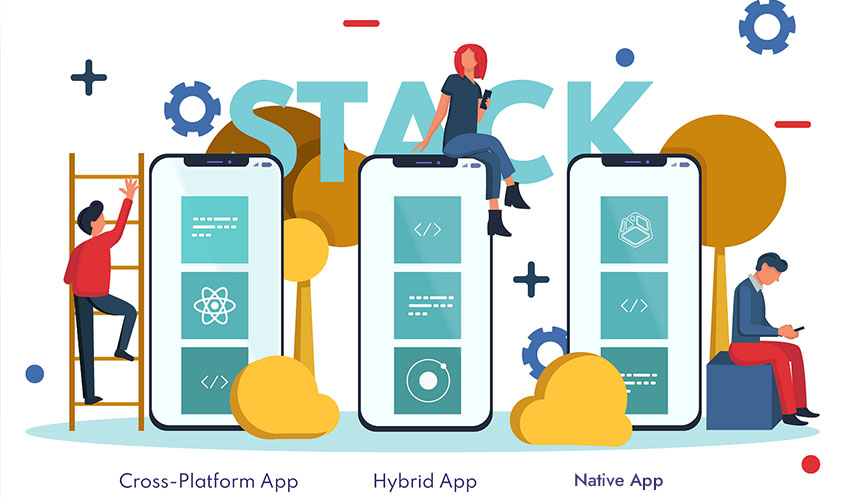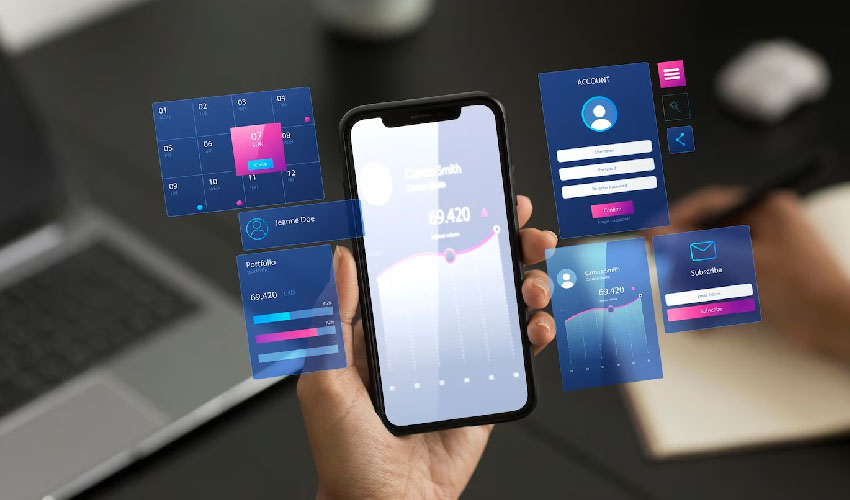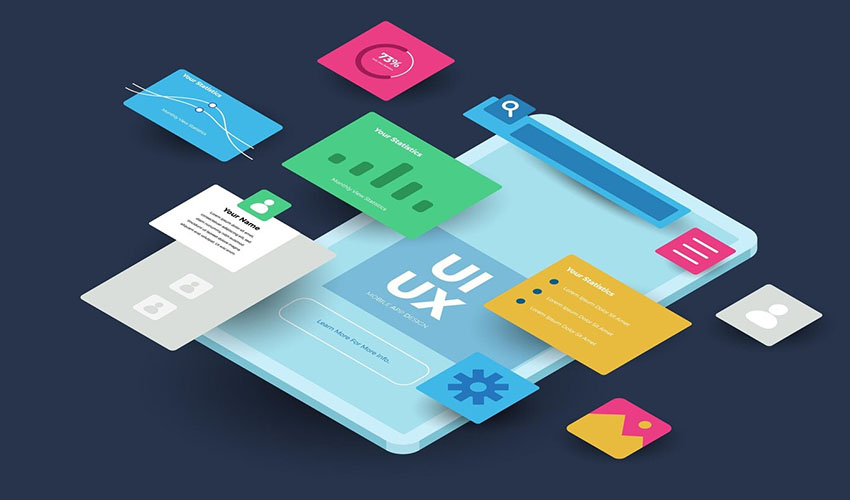Table of Contents
Overview of Mobile App Tech Stacks
Certainly! Crafting a successful mobile app involves selecting a robust tech stack that aligns with your project’s requirements, scalability needs, and user expectations. A tech stack typically comprises various layers of software development tools, frameworks, programming languages, and libraries used to build and maintain an application. As of now, several prominent tech stacks cater to diverse app development needs. Let’s explore these stacks across different layers
Native App Development:
iOS Development:
Objective-C was the primary language for iOS app development until Swift emerged in 2014. Swift gained popularity for its modern syntax, safety features, and performance enhancements. Xcode, Apple’s integrated development environment (IDE), remains the standard tool for iOS development, offering a suite of features for coding, debugging, and testing.
Android Development:
Java has been a stalwart in Android app development for years. However, Kotlin gained recognition as an official language for Android development in 2017 due to its concise syntax, null safety, and seamless interoperability with Java. Android Studio, the official IDE, provides a rich set of tools for building and optimizing Android apps.
Cross-Platform App Development:
React Native:
Developed by Facebook, React Native enables building cross-platform apps using JavaScript and React. It allows developers to create native-like experiences for both iOS and Android with a single codebase. React Native’s component-based architecture and reusable code components streamline development.
Flutter:
Introduced by Google, Flutter gained traction for its ability to create visually appealing, high-performance apps with a single codebase. Utilizing Dart as its programming language, Flutter’s hot reload feature allows real-time code changes, speeding up the development process.
Backend Technologies:
Node.js:
Powered by Google’s V8 JavaScript engine, Node.js allows developers to build scalable and efficient server-side applications using JavaScript. Its non-blocking, event-driven architecture makes it suitable for real-time applications.
Ruby on Rails:
Ruby on Rails simplifies backend development by emphasizing convention over configuration. Its MVC (Model-View-Controller) framework and a vast array of gems (libraries) expedite development while maintaining code quality.
Database Choices:
SQL Databases:
MySQL and PostgreSQL remain popular choices for relational databases due to their robustness, ACID compliance, and wide community support.
NoSQL Databases:
MongoDB and Firebase gained prominence for their flexibility and scalability in handling unstructured data. They offer document-oriented storage and horizontal scaling capabilities.
Additional Considerations:
- Cloud Services: Platforms like AWS (Amazon Web Services), Google Cloud Platform, and Microsoft Azure provide scalable infrastructure and services essential for app deployment, storage, and computation.
- Security Measures: Incorporating robust security measures, such as encryption, secure authentication mechanisms, and regular security audits, is crucial to protect user data and prevent breaches.
- AI and ML Integration: Integrating artificial intelligence (AI) and machine learning (ML) capabilities using libraries like TensorFlow or PyTorch can enhance app functionalities, such as personalization, recommendation engines, and predictive analysis.
Selecting the right tech stack for your mobile app involves evaluating factors like scalability, development speed, ecosystem support, and long-term maintenance. While these tech stacks offer various advantages, the choice ultimately depends on the specific project requirements, team expertise, and the targeted user experience. Understanding the strengths and weaknesses of each stack empowers developers to create powerful, user-friendly mobile applications.
Tech Stack Trends in 2024
Certainly! In 2024, the evolution of technology continues to reshape the landscape of mobile app development, propelling the industry towards innovation, efficiency, and user-centric solutions. Understanding the prevailing tech stack trends is crucial for developers and businesses aiming to create cutting-edge mobile applications that stand out in a competitive market.
Native App Development Evolution
iOS Development: Apple’s iOS ecosystem sees a continued refinement in development tools. Swift, Apple’s programming language, matures further, offering enhanced performance and safety features. The SwiftUI framework gains prominence, simplifying UI development by employing a declarative syntax and providing powerful tools for creating engaging user interfaces.
Android Development: Kotlin maintains its momentum as the preferred language for Android app development. Its concise coding style and interoperability with Java make it a go-to choice. Android Studio, the official IDE, undergoes upgrades to streamline the development process, fostering faster iteration and higher-quality app output.
Rise of Cross-Platform Solutions
Flutter’s Dominance: Flutter, Google’s UI toolkit, continues to gain traction for its ability to build natively compiled applications for multiple platforms using a single codebase. Its hot reload feature enables rapid development and experimentation, while its comprehensive widget library facilitates the creation of visually appealing and performant apps.
React Native’s Persistence: React Native remains a popular choice among developers due to its robust community support, enabling cross-platform app development using JavaScript and React. Its ability to deliver near-native performance while sharing a significant portion of code across platforms keeps it relevant in 2024.
Backend Technologies Paving the Way
Node.js in Scalable Solutions: Node.js remains a dominant force in backend development, owing to its event-driven architecture and non-blocking I/O model that enables handling concurrent connections efficiently. Frameworks like Express.js continue to complement Node.js, offering a minimalist approach for building scalable APIs and web applications.
Serverless Architecture’s Expansion: The trend towards serverless architecture amplifies as more companies embrace the pay-as-you-go model and abstracted infrastructure management. Platforms such as AWS Lambda, Google Cloud Functions, and Azure Functions empower developers to focus solely on writing code without worrying about server provisioning or scaling.
Database Paradigms for Performance
GraphQL’s Data Querying Efficiency: GraphQL gains momentum for its efficiency in fetching data, allowing clients to request precisely the needed information, reducing over-fetching and under-fetching scenarios. Its ability to aggregate data from multiple sources simplifies complex data querying requirements.
NoSQL Databases’ Flexibility: The versatility of NoSQL databases, particularly MongoDB and Firebase, continues to appeal to developers for their schema-less design, scalability, and ease of use. These databases cater well to the dynamic data requirements of modern applications.
Integrating Advanced Technologies
AI/ML Integration: The integration of Artificial Intelligence (AI) and Machine Learning (ML) into mobile apps becomes more prevalent. Libraries like TensorFlow and PyTorch enable developers to implement intelligent features such as predictive analysis, natural language processing, and image recognition, enhancing user experience and personalization.
Enhanced Security Measures: As data breaches persist as a major concern, mobile app developers prioritize robust security measures. Implementing end-to-end encryption, multi-factor authentication, and regular security audits becomes imperative to safeguard user data and maintain trust.
Cross-Platform Development Stacks

Understanding Cross-Platform Development
Cross-platform development allows developers to write code once and deploy it across multiple platforms, reducing development time and costs while maintaining a consistent user experience. These frameworks facilitate app creation using a single codebase, targeting multiple operating systems.React Native
Developed by Facebook, React Native stands as a prominent choice for cross-platform development. It utilizes JavaScript and React to build native-like apps. Its “learn once, write anywhere” philosophy appeals to developers proficient in web technologies.Advantages:
- Performance: React Native’s architecture facilitates high performance by rendering components as native widgets, offering a near-native experience.
- Large Community: Its vast community contributes libraries, tools, and solutions, fostering rapid development and issue resolution.
- Hot Reloading: Developers can instantly see changes without recompiling, accelerating the development cycle.
Disadvantages:
- Native Modules: For functionalities not supported by React Native, integration of native modules might be necessary, potentially adding complexity.
- Version Compatibility: Frequent updates may lead to compatibility issues with third-party libraries or modules.
Flutter
Flutter, backed by Google, has gained significant traction for its ability to create natively compiled applications for mobile, web, and desktop from a single codebase using the Dart programming language.Advantages:
- Performance: Flutter’s architecture enables high performance by directly compiling to native ARM code, ensuring smooth and fast operation.
- Hot Reload: Similar to React Native, Flutter offers a hot reload feature for quick iterations and bug fixing.
- Customizable Widgets: Its rich set of customizable widgets facilitates building complex UIs easily.
Disadvantages:
- Learning Curve: Developers new to Dart might face a learning curve initially.
- Large App Size: Including all necessary libraries might increase app size, impacting download times.
Xamarin
Owned by Microsoft, Xamarin uses C# and .NET to build cross-platform apps. It allows sharing a significant amount of code across platforms while delivering a native-like user experience.Advantages:
- Performance: Xamarin provides near-native performance due to direct access to native APIs.
- Integration with Microsoft Ecosystem: Seamless integration with Microsoft tools and services simplifies development for developers familiar with the ecosystem.
- Code Reusability: With shared codebases, developers can reuse a substantial portion of code across platforms.
Disadvantages:
- Community Size: Despite Microsoft’s backing, Xamarin’s community is relatively smaller compared to Flutter or React Native.
- Platform-Specific Code: Occasionally, developers need to write platform-specific code to access certain features, deviating from the single codebase concept.
Ionic
Ionic is an open-source framework built on top of Angular and Apache Cordova, using web technologies like HTML, CSS, and JavaScript to create hybrid mobile apps.Advantages:
- Ease of Learning: Developers familiar with web technologies can quickly adapt to Ionic.
- Cost-Effectiveness: It allows using web developers for mobile app development, reducing the need for specialized native developers.
- Plugin Ecosystem: Ionic offers a wide array of plugins for extending functionalities.
Disadvantages:
- Performance: Compared to native or near-native frameworks, Ionic apps might face performance issues, especially with complex functionalities or animations.
- Limited Access to Native Features: Access to device features might be limited compared to fully native apps.
Choosing the Right Stack
The choice of a cross-platform development stack depends on various factors:
- Project Requirements: Consider the app’s complexity, performance needs, and integration of native features.
- Developer Expertise: Choose a stack aligning with the team’s expertise to expedite development and maintain code quality.
- Long-Term Goals: Evaluate scalability, maintenance, and future platform support for the chosen framework.
Native vs. Hybrid vs. Web-Based Tech Stacks
In the realm of mobile app development, the choice of technology stack plays a pivotal role in determining the app’s performance, user experience, and overall success. The three primary approaches—Native, Hybrid, and Web-Based—offer distinct advantages and trade-offs, catering to different development needs, platform requirements, and user expectations.
1. Native App Development
Overview: Native app development involves building applications specifically for a single platform using programming languages and tools native to that platform.
Pros:
- Performance: Native apps offer the best performance as they are optimized for the specific platform’s hardware and software.
- User Experience: They provide a seamless and intuitive user experience, leveraging the platform’s native UI elements and functionalities.
- Access to Device Features: Developers can fully utilize the device’s features like camera, GPS, sensors, etc., for enhanced app capabilities.
- App Store Optimization: Native apps can leverage platform-specific app stores (e.g., Apple App Store, Google Play Store) for better visibility and discoverability.
Cons:
- Development Time: Building separate codebases for different platforms (iOS and Android) increases development time and cost.
- Maintenance: Maintenance becomes more complex, requiring separate updates and bug fixes for each platform.
- Skills Required: Developers need expertise in platform-specific languages and frameworks (Swift or Objective-C for iOS, Kotlin or Java for Android).
2. Hybrid App Development
Overview: Hybrid apps are developed using web technologies (HTML, CSS, JavaScript) and are wrapped in a native container to run on multiple platforms.
Pros:
- Cross-Platform Compatibility: A single codebase can be used across multiple platforms (iOS, Android), reducing development time and cost.
- Faster Development: Using web technologies allows for quicker development compared to building separate native apps.
- Unified Maintenance: Updates and bug fixes can be done centrally for both platforms, streamlining maintenance efforts.
- Access to Device Features: Hybrid frameworks often provide plugins or APIs to access native device functionalities.
Cons:
- Performance: Hybrid apps might face performance issues compared to native apps due to the overhead of running in a container and not being fully optimized for each platform.
- Limited Native Features: Access to certain native functionalities might be limited or require additional plugins, which may affect app capabilities.
- UI/UX Challenges: Achieving the same level of UI/UX as native apps can be challenging due to differences in native elements and design guidelines.
- Dependency on Third-Party Tools: Hybrid development heavily relies on third-party tools and frameworks, which may pose risks in terms of compatibility and support.
3. Web-Based App Development
Overview: Web-based apps are essentially websites optimized for mobile devices, accessed through a mobile browser.
Pros:
- Cross-Platform Accessibility: Web-based apps are accessible across various devices and platforms, offering the broadest reach.
- Easier Updates: Updates are immediate and don’t require user downloads or app store approvals, ensuring users have the latest version.
- Development Simplicity: Developers can leverage existing web development skills and tools to create mobile web apps.
- Lower Development Cost: Web-based apps typically have lower development costs compared to native or hybrid apps.
Cons:
- Limited Functionality: Access to native device features (camera, sensors, etc.) is limited compared to native or hybrid apps.
- Performance Constraints: Performance might be slower compared to native apps, especially for complex functionalities or graphics-intensive applications.
- Offline Accessibility: Web-based apps heavily rely on an internet connection, limiting their functionality in offline scenarios.
- Less Discoverability: Unlike apps listed in app stores, web-based apps might have lower visibility and discoverability.
Optimizing UI/UX through Tech Stacks
Optimizing UI/UX through tech stacks is crucial for ensuring an engaging and user-friendly experience in modern applications. Let’s explore this in-depth:
The Role of Tech Stacks in UI/UX Optimization
Understanding UI/UX Optimization
User Interface (UI) and User Experience (UX) are integral aspects of any successful application. UI focuses on the visual elements, such as layout, colors, typography, and interactive components, while UX delves into the overall experience, encompassing usability, accessibility, and the emotional connection users have with the app.
Optimizing UI/UX involves leveraging the right combination of technologies, frameworks, and tools within a tech stack to create a seamless, intuitive, and aesthetically pleasing user experience.
Choosing the Right Tech Stack for UI/UX Optimization
Native App Development
- iOS Development: Utilizing Swift and SwiftUI along with Xcode as the IDE ensures a smooth and native experience for iOS users. SwiftUI’s declarative syntax streamlines UI development, enabling developers to create responsive and visually appealing interfaces.
- Android Development: Kotlin paired with Android Studio provides a powerful combination for crafting native Android apps. Kotlin’s concise syntax and interoperability with Java simplify development while ensuring performance and reliability.
Cross-Platform Development
- Flutter: Google’s Flutter framework enables building visually rich and native-like interfaces for both iOS and Android using a single codebase. Its hot reload feature expedites UI development, allowing real-time changes and enhancements.
- React Native: Leveraging JavaScript and React, React Native facilitates the creation of cross-platform apps with a native feel. Its extensive library of components aids in building consistent and responsive UIs.
Backend Technologies and UI/UX Optimization
Node.js and Serverless Architecture
- Node.js: Its non-blocking, event-driven architecture makes it ideal for real-time applications, enhancing the user experience through swift and responsive interactions.
- Serverless Architecture: Platforms like AWS Lambda or Google Cloud Functions streamline backend operations, allowing developers to focus on enhancing front-end user experiences.
Database Choices and UI/UX Enhancement
GraphQL and NoSQL Databases
- GraphQL: With its ability to fetch precise data, GraphQL reduces unnecessary data fetching, optimizing app performance and responsiveness. This directly impacts user experience by ensuring faster load times and smoother interactions.
- NoSQL Databases: MongoDB, Firebase, and similar NoSQL databases offer scalability and flexibility, allowing for efficient data handling and retrieval, thus contributing to a seamless user experience.
Additional Enhancements for UI/UX Optimization
Integration of AI/ML Capabilities
- TensorFlow and PyTorch: Integrating machine learning capabilities can personalize user experiences through predictive analysis, recommendation engines, and content personalization.
Emphasizing Cybersecurity Measures
- Encryption and Secure Authentication: Implementing robust security measures is essential to protect user data and foster trust. Encryption techniques and secure authentication methods enhance the overall user experience by ensuring data privacy and integrity.
Best Practices and Considerations for UI/UX Optimization
- Performance Optimization: Optimizing app performance through efficient coding practices, minimizing load times, and optimizing images and assets contributes significantly to a positive user experience.
- Accessibility and Inclusivity: Ensuring accessibility features and designing for diverse user needs fosters inclusivity, making the app usable by a broader audience.
- User Testing and Feedback: Continuous user testing and feedback collection aid in identifying pain points and areas for improvement in the UI/UX, guiding iterative enhancements.
Cost-Effective Tech Stack Strategies
Building a cost-effective tech stack involves optimizing resources without compromising quality. Here’s a comprehensive guide to achieving this:
1. Define Clear Objectives and Requirements
Begin by defining precise project objectives and requirements. Understanding your app’s purpose, target audience, and expected scalability helps in making informed decisions. Identify must-have features versus nice-to-have ones, enabling prioritization without over-engineering.
2. Choose the Right Development Approach
a. Native vs. Cross-Platform Development
Evaluate whether a native or cross-platform approach suits your project. While native apps offer high performance, they require separate codebases for different platforms, potentially escalating costs. Cross-platform frameworks like React Native or Flutter might offer cost savings by using a single codebase for multiple platforms.
3. Selecting the Tech Stack Components
a. Frontend Technologies
Consider the pros and cons of frontend technologies:
- JavaScript Frameworks:
- React and Vue.js offers robust performance and a vibrant community, reducing development time and expenses.
- CSS Frameworks:
- Utilizing lightweight CSS frameworks like Bootstrap or Tailwind CSS aids in faster UI development without compromising aesthetics.
b. Backend Technologies
Opt for cost-effective backend solutions:
- Serverless Architecture:
- Platforms like AWS Lambda or Google Cloud Functions eliminate infrastructure costs, charging based on usage, thus reducing expenses.
- Node.js:
- Node.js, known for its scalability and asynchronous nature, is cost-efficient due to its performance capabilities and large community support.
c. Database Choices
- Open Source Databases:
- Leveraging open-source databases like MySQL or PostgreSQL helps avoid licensing fees while ensuring reliability and scalability.
- NoSQL Databases:
- Consider using NoSQL databases such as MongoDB or Firebase, offering flexibility and scalability without the constraints of traditional relational databases.
4. Optimizing Cloud Services
a. Cloud Infrastructure
Choose cloud providers offering cost-effective services:
- AWS, Azure, Google Cloud:
- Utilize cost calculators and choose services that align with your project’s needs. Reserved instances or spot instances in AWS can significantly reduce costs for long-term usage.
- Serverless Computing:
- Adopt serverless computing to pay only for the resources consumed, scaling automatically based on demand.
5. Implement Efficient Development Practices
a. Continuous Integration/Continuous Deployment (CI/CD)
- Embrace CI/CD pipelines to automate testing and deployment, reducing errors and development time, hence saving costs on fixing issues.
b. Agile Methodologies
- Implement Agile methodologies for iterative development, allowing for frequent updates and course corrections early in the development phase, preventing costly overhauls later.
6. Considerations for Cost-Efficient Scalability
a. Scalability Planning
Plan for scalability from the outset to avoid unforeseen expenses later. Design an architecture that can efficiently scale based on user demand without incurring significant additional costs.
7. Security Measures
Prioritize security to prevent potential breaches that can incur substantial financial losses. Implementing robust encryption, secure authentication mechanisms, and regular security audits can save significant expenses in the long run.
Industry-Specific Tech Stack Considerations
Let’s explore industry-specific considerations for crafting the ideal tech stack for various sectors.
1. Healthcare Industry:
The healthcare sector demands robust security and compliance measures due to sensitive patient data. The tech stack should prioritize:
- HIPAA Compliance: Utilizing languages like Python or Java for backend development alongside frameworks like Django ensures compliance.
- Interoperability: Technologies like HL7 and FHIR facilitate interoperability between different healthcare systems and devices.
- Telemedicine: Integrating real-time communication features via WebRTC or Twilio for video consultations.
2. Finance and Fintech:
Security, scalability, and real-time data processing are paramount in finance-related apps:
- Security Measures: Utilizing Java or C# for backend development ensures robust security. Integrating encryption tools and adhering to compliance standards like PCI-DSS is crucial.
- Blockchain Integration: For fintech apps, leveraging blockchain technologies like Ethereum or Hyperledger ensures secure and transparent transactions.
- Real-Time Analytics: Implementing technologies like Apache Kafka or Spark for real-time data processing and analytics.
3. E-commerce:
E-commerce apps focus on user experience, scalability, and seamless transactions:
- Scalable Infrastructure: Utilizing cloud services like AWS or Google Cloud ensures scalability during high traffic periods.
- Personalization: Implementing Machine Learning algorithms for recommendation engines to enhance user experience.
- Payment Gateways: Integration with secure payment gateways like Stripe or PayPal for seamless transactions.
4. Education and E-Learning:
Educational apps require engagement features and intuitive interfaces:
- Content Delivery Networks (CDN): Implementing CDNs for quick content delivery and reducing latency.
- Collaborative Tools: Integration of real-time collaboration features using technologies like WebRTC or Socket.io.
- Learning Analytics: Utilizing data analytics tools to track user progress and provide personalized learning paths.
5. Travel and Hospitality:
The travel industry requires real-time updates, geolocation features, and seamless bookings:
- Geolocation Services: Integrating services like Google Maps API for location-based services and directions.
- Payment Integration: Facilitating secure and quick payments using Apple Pay, Google Pay, or Stripe.
- Dynamic Updates: Implementing push notification systems to provide real-time updates on flights, hotel bookings, etc.
6. Gaming:
Gaming apps prioritize high performance, immersive experiences, and social interactions:
- Game Engines: Leveraging Unity or Unreal Engine for high-performance game development.
- Real-Time Communication: Integration of WebSockets or Photon for real-time multiplayer gaming experiences.
- In-App Purchases: Implementing secure and seamless in-app purchase systems for virtual goods.
Evaluating the Right Tech Stack for Your App
A tech stack comprises layers of software components and tools that form the foundation of an application. It typically includes:
- Frontend Development: The user interface (UI) layer visible to users.
- Backend Development: The server, application, and database layers handling the app’s logic and data.
- Development Tools: Integrated Development Environments (IDEs), frameworks, and libraries used in the development process.
Factors Influencing Tech Stack Selection
1. Nature of the Application
Consider the type of app you’re building. Is it a web app, mobile app, or a combination of both (hybrid)? This influences the choice between native and cross-platform development.
2. Scalability Requirements
The ability of your app to handle increased load and user base is critical. Scalability considerations affect backend technologies and cloud infrastructure choices.
3. Performance Expectations
Performance impacts user experience. Factors like response time, rendering speed, and resource utilization drive the choice of programming languages, frameworks, and databases.
4. Developer Expertise
Evaluate your team’s skills and familiarity with specific technologies. Choosing technologies they’re proficient in can accelerate development and reduce learning curves.
5. Time-to-Market
For rapid deployment, some frameworks or tools offer quicker development cycles. Balancing speed with long-term scalability is crucial here.
6. Security Requirements
Assess the sensitivity of data and regulatory compliance needs. Security measures influence choices in backend technologies and cloud services.
Components of an Ideal Tech Stack
Frontend Development
- JavaScript Frameworks: React, Angular, or Vue.js offer robust frontend development capabilities. They ensure a responsive, interactive UI.
- CSS Frameworks: Bootstrap and Tailwind CSS simplify styling and ensure consistency across devices.
- Mobile Development: For native mobile apps, Swift for iOS and Kotlin for Android remain top choices. Alternatively, cross-platform frameworks like React Native or Flutter provide efficiency in developing for both platforms simultaneously.
Backend Development
- Programming Languages: Node.js, Python, Ruby, or Go offer scalability and performance. Choose based on familiarity and suitability for your app’s requirements.
- Frameworks: Express.js for Node.js, Django for Python, or Ruby on Rails for Ruby provide robust backend structures.
- Database Systems: Consider relational databases like PostgreSQL or MySQL for structured data and NoSQL databases like MongoDB for flexibility and scalability.
Cloud Services and Deployment
- Cloud Providers: AWS, Azure, Google Cloud offer a range of services for hosting, storage, and computation.
- Containers and Orchestration: Docker for containerization and Kubernetes for orchestration ensure scalability and efficient deployment.
Additional Considerations
- APIs and Integrations: Choose technologies that facilitate seamless integrations with external services and APIs.
- Security Measures: Implement encryption, secure authentication, and regular updates to ensure data protection.
- Community Support and Future Proofing: Consider technologies with active communities, regular updates, and long-term support to future-proof your app.





















